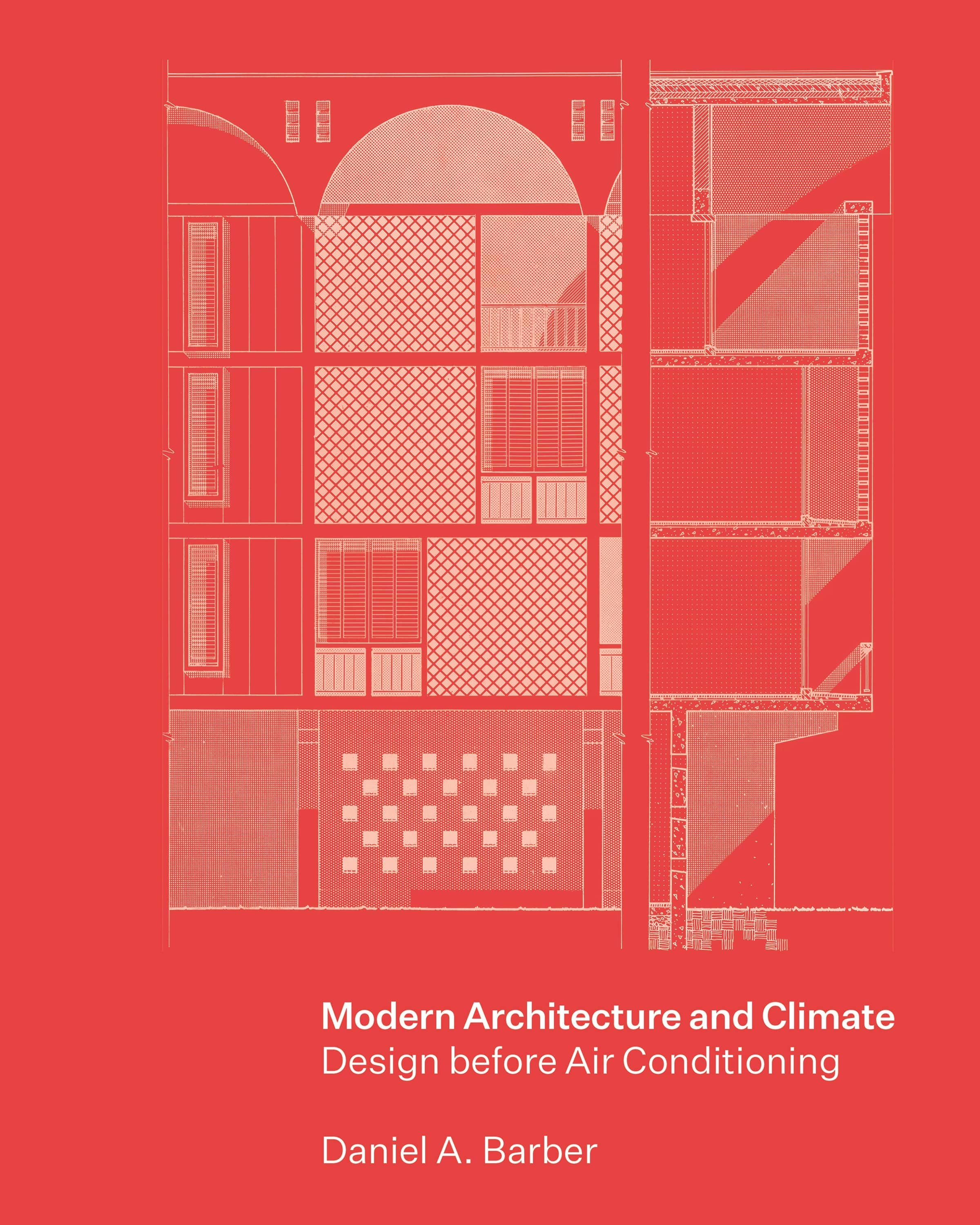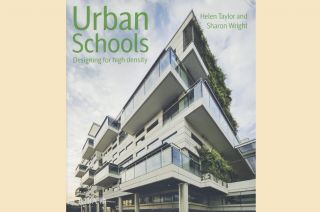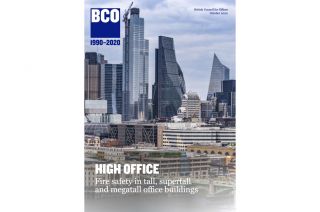
www.buildingsandcities.org/insights/reviews/modern-architecture-and-climate-design-review.html
Modern Architecture and Climate Design before Air Conditioning
By Daniel A. Barber. Princeton University Press, 2020, ISBN: 978-691170039.
Alan Short (University of Cambridge) reviews this book which explores the history of modern architecture from the perspective of climate, especially explaining the growing dominance of energy dependent buildings.
 This book's author is an Associate
Professor of Architecture at the Stuart Weitzman School of Design at the University
of Pennsylvania and therefore, rather unusually and refreshingly, this is a
piece of historical research about the Architecture of the relatively recent
past assembled by someone with design training, albeit in the nuanced form of a
Yale Masters in Environmental Design. His latest project is an exposé of
profligate energy dependent buildings as de facto stranded assets in the
coming zero carbon age, the subject of Mark Carney's final speech as Governor
of the Bank of England and an issue which is likely to affect the course of
Architecture profoundly. It will bring into being a very different value system
which will surely be used to reevaluate the potential of the existing building
stock and husband the rise of what the author terms 'Post-Carbonism', a new
style to eclipse Post-Modernism.
This book's author is an Associate
Professor of Architecture at the Stuart Weitzman School of Design at the University
of Pennsylvania and therefore, rather unusually and refreshingly, this is a
piece of historical research about the Architecture of the relatively recent
past assembled by someone with design training, albeit in the nuanced form of a
Yale Masters in Environmental Design. His latest project is an exposé of
profligate energy dependent buildings as de facto stranded assets in the
coming zero carbon age, the subject of Mark Carney's final speech as Governor
of the Bank of England and an issue which is likely to affect the course of
Architecture profoundly. It will bring into being a very different value system
which will surely be used to reevaluate the potential of the existing building
stock and husband the rise of what the author terms 'Post-Carbonism', a new
style to eclipse Post-Modernism.
What might this Post-Carbon
architecture be like? Barber's latest book Modern Architecture and Climate Design before Air
Conditioning sets the context for the
present conundrum, the rise of the lightweight glassy tower and various architectural
attempts to counter the climate-induced ill consequences for their occupants'
enjoyment of them. He places his account into the loose tendency he identifies
as a revisionist history of modernism, unthinkable and foolhardy only forty
years ago. It is a partial history of Modern Architecture from the perspective
of climate, a theme not so thoroughly pursued since the late 1940s flurry of
books on climate as a driver of health, energy, 'civilisation', productivity
and good and bad behaviours. He attacks his subject, a carefully identified
body of intentionally climate-modifying modernist works, through three
interconnected themes: climate, the facade and comfort. He describes comfort as
'the hinge' which will ultimately and inevitably provoke the invention of an
authentic and productive Post-Carbon Architecture. Can we read the examples he provides
as exemplars for this future Architecture, at least as works in progress? We
need to read on.
Barber identifies Pietro Belluschi's 1947 Equitable Insurance Building in Portland Oregon as the first fully sealed, curtain walled building to be wholly reliant on air conditioning. Belluschi subcontracted the making of an acceptable indoor environment to air conditioning engineers in its entirety. Le Corbusier with his collaborator Gustave Lyon, the acoustician, attempted to home build sophisticated, yet misconceived, one-off building scale environmental solutions. These include the mur neutralisant, never fully realized but doomed on paper by the physics of the natural world and, at the Cité-Refuge de L'Armé du Salut, so malfunctioning as William Curtis tells us, to provoke a police warning. Curtis's account of the same episode suggests that the author is giving us a rather rose-tinted version of the story of Xenakis' hurried design for the corrective brise soleil which finally led to a police discharge for his employer. In Moscow the proposed mur neutralisant earned the contempt of the Soviets, Molotov no less, reinforced by an elaborately polite but damning letter from the Detroit-based American Blower Corporation, discovered by Rosa Urbano Gutiérrez, uncatalogued in the Paris archive.
Barber very perceptively interprets
Le Corbusier's interventions into his own office's façade designs by the early
1930s as, 'a fraught attempt to modernize traditional means for climate
management - to technologize the louvres, screens, blinds, extended eaves, and
many other techniques that have been used to shade interiors for centuries'
(p.39). An extreme reluctance by designers of a certain on-trend ilk to
besmirch the seamless membranes that technological refinements have made
possible with the bric-a-brac of external sun shading is still very evident today,
witness Zaha Hadid's practice's baffling all glass OPUS building in Dubai.
It is quite a shock to see the arch environmental determinist Ellsworth Huntington's map showing 'The Distribution of Human Energy on the basis of Climate' reproduced with almost no comment. It is Figure 26B in Huntington's 1919 apologia for German First World War aggression, 'Germany and her Neighbours' (Ch.XIII) in World-Power and Evolution. It has not yet become 'The Distribution of Human Health and Energy on the Basis of Climate' as quoted from the 1924 edition which invites a more benign interpretation. In fact it is a deliberately racist rant and the sister map (Figure 26A) purports to show 'The Distribution of Civilization' very much to the disadvantage of all inhabitants of warmer climates, not least Asia and Africa. Huntington's very popular books were published by Yale University Press, not their finest moment. Here there is perhaps a touch of naivety in Barber's commentary. The colonial powers were deeply concerned for the moral welfare of their envoys sent out to warmer and especially more humid environments which were thought to engender moral degradation. The geographer Rätzel's concept of Anthropogeography was corrupted by his pupil Ellen Semple so that by 1911 she was publishing well-received work on 'Temperature and race temperament' and the 'Temperate zone as cradle of civilisation'. From her Anthropogeographical perspective, air conditioning could export the cool temperate climate to envelope all decent Westerners and even rescue a small number of trusted locals and it was necessary to make the Modern Architecture Barber focusses on, habitable.
The author focuses on concrete framed slabs dressed in heavy concrete meshes with lighter weight infill panels, 'Brutalism light'. The all-glass buildings which have come to characterize global business and which really do threaten the arrival of Post-Carbon Architecture derive from another source, the phantasmological Glasarchitektur of the poet Scheerbart's prewar Berlin, in large part ironic, but accidentally tipped into the milieu of undiscriminating American industrial knowhow by the exiled Mies van der Rohe. A single image of the model of his Friedrichstrasse tower was the rapacious bacillus, the super-spreader which fuelled the pandemic of late modern glassy architecture, the future stranded assets of our built environment.
The book is strongest on the American post-war experience. Neutra's school classroom innovations in Puerto Rico, published in the June 1946 L'Architecture d'Aujourd'hui showing how 'airborne germs are blown out', come to nothing. Harrison and Ambrowitz's sealed air conditioned Havana embassy eclipsed bioclimatic design. US embassy designs acquired unproven screens across glazed facades consciously attuned to the local vernacular to expedite local appreciation of the 'New Look' foreign policy. As Koenigsberger and Fry established the Tropical Architecture unit in London's Architectural Association, American military climate scientists started to go public on the importance of their new grasp of microclimate. Landsberg's study of climate-driven site selection appeared in Architectural Forum, indistinguishable from an air force bombing map. James Marston Fitch was trained as a military weather forecaster. His House Beautiful's 'Climate Control Project' started well but descended into xenophobic attacks on the European modern movement, Mies and Corbusier's 'Cult of Austerity', a 'Threat to the Next America' featured in the April 1953 issue. The Hungarian bioclimaticists the Olgyay brothers at Princeton (funded, we discover, by the Guggenheim Foundation) pursued the quantification of comfort and environmental response in the Gropius manner. The 1952 Building Research Advisory Board exposed the long standing conundrum, the condition of the human being as a 'uniform sociophysiological entity', globally, the Olgyays' proposition as opposed to the regionally adapted citizen celebrating difference. The discussion degenerated into gender and racial bias. Clarence Mills was recorded saying, 'As anyone knows who has taken a wife (to the tropics)…. It hurts the women' (p.211). Racial differences in heat tolerances were credited to nutrition, health and incentivization, whatever that meant. Environmental determinism had become so discredited that mention of a suspected climate associated difference became inadmissable. Owen Lattimore and Gordon Manley lampooned Huntington's theory, laughing at his, '… romantic explanation of hordes of erratic nomads, ready to start for lost horizons at the joggle of a barometer in search of suddenly vanishing pastures' (Manley, 1944, p.220). In any case the universal availability of air conditioning had evaporated that awkward suspicion. By page 263 we are introduced to the concept of adaptive comfort proposing that short, medium and long term habituation within rising or falling running mean temperatures induced a much more complex dynamic sense of comfort challenging all hard line bioclimatic modernist design principles. We have been looking at historical oddities not prescient harbingers of a Post Carbon future.
References
Manley, G. (1944). Some recent contributions to the study of climatic change, Quarterly Journal Royal Meteorological Society, 70, 197-220.
Latest Peer-Reviewed Journal Content
A framework for 1.5°C-aligned GHG budgets in architecture
G Betti, I Spaar, D Bachmann, A Jerosch-Herold, E Kühner, R Yang, K Avhad & S Sinning
Net zero retrofit of the building stock [editorial]
D Godoy-Shimizu & P Steadman
Co-learning in living labs: nurturing civic agency and resilience
A Belfield
The importance of multi-roles and code-switching in living labs
H Noller & A Tarik
Researchers’ shifting roles in living labs for knowledge co-production
C-C Dobre & G Faldi
Increasing civic resilience in urban living labs: city authorities’ roles
E Alatalo, M Laine & M Kyrönviita
Co-curation as civic practice in community engagement
Z Li, M Sunikka-Blank, R Purohit & F Samuel
Preserving buildings: emission reductions from circular economy strategies in Austria
N Alaux, V Kulmer, J Vogel & A Passer
Urban living labs: relationality between institutions and local circularity
P Palo, M Adelfio, J Lundin & E Brandão
Living labs: epistemic modelling, temporariness and land value
J Clossick, T Khonsari & U Steven
Co-creating interventions to prevent mosquito-borne disease transmission in hospitals
O Sloan Wood, E Lupenza, D M Agnello, J B Knudsen, M Msellem, K L Schiøler & F Saleh
Circularity at the neighbourhood scale: co-creative living lab lessons
J Honsa, A Versele, T Van de Kerckhove & C Piccardo
Positive energy districts and energy communities: how living labs create value
E Malakhatka, O Shafqat, A Sandoff & L Thuvander
Built environment governance and professionalism: the end of laissez-faire (again)
S Foxell
Co-creating justice in housing energy transitions through energy living labs
D Ricci, C Leiwakabessy, S van Wieringen, P de Koning & T Konstantinou
HVAC characterisation of existing Canadian buildings for decarbonisation retrofit identification
J Adebisi & J J McArthur
Simulation and the building performance gap [editorial]
M Donn
Developing criteria for effective building-sector commitments in nationally determined contributions
P Graham, K McFarlane & M Taheri
Reimagining circularity: actions for optimising the use of existing buildings
R Lundgren, R Kyrö, S Toivonen & L Tähtinen
Effective interdisciplinary stakeholder engagement in net zero building design
S Vakeva-Baird, F Tahmasebi, JJ Williams & D Mumovic
Metrics for building component disassembly potential: a practical framework
H Järvelä, A Lehto, T Pirilä & M Kuittinen
The unfitness of dwellings: why spatial and conceptual boundaries matter
E Nisonen, D Milián Bernal & S Pelsmakers
Environmental variables and air quality: implications for planning and public health
H Itzhak-Ben-Shalom, T Saroglou, V Multanen, A Vanunu, A Karnieli, D Katoshevski, N Davidovitch & I A Meir
Exploring diverse drivers behind hybrid heating solutions
S Kilpeläinen, S Pelsmakers, R Castaño-Rosa & M-S Miettinen
Urban rooms and the expanded ecology of urban living labs
E Akbil & C Butterworth
Living with extreme heat: perceptions and experiences
L King & C Demski
A systemic decision-making model for energy retrofits
C Schünemann, M Dshemuchadse & S Scherbaum
Modelling site-specific outdoor temperature for buildings in urban environments
K Cebrat, J Narożny, M Baborska-Narożny & M Smektała
Understanding shading through home-use experience, measurement and modelling
M Baborska-Narożny, K Bandurski, & M Grudzińska
Building performance simulation for sensemaking in architectural pedagogy
M Bohm
Beyond the building: governance challenges in social housing retrofit
H Charles
Heat stress in social housing districts: tree cover–built form interaction
C Lopez-Ordoñez, E Garcia-Nevado, H Coch & M Morganti
An observational analysis of shade-related pedestrian activity
M Levenson, D Pearlmutter & O Aleksandrowicz
Learning to sail a building: a people-first approach to retrofit
B Bordass, R Pender, K Steele & A Graham
Market transformations: gas conversion as a blueprint for net zero retrofit
A Gillich
Resistance against zero-emission neighbourhood infrastructuring: key lessons from Norway
T Berker & R Woods
Megatrends and weak signals shaping future real estate
S Toivonen
A strategic niche management framework to scale deep energy retrofits
T H King & M Jemtrud
Generative AI: reconfiguring supervision and doctoral research
P Boyd & D Harding
Exploring interactions between shading and view using visual difference prediction
S Wasilewski & M Andersen
How urban green infrastructure contributes to carbon neutrality [briefing note]
R Hautamäki, L Kulmala, M Ariluoma & L Järvi
Implementing and operating net zero buildings in South Africa
R Terblanche, C May & J Steward
Quantifying inter-dwelling air exchanges during fan pressurisation tests
D Glew, F Thomas, D Miles-Shenton & J Parker
Western Asian and Northern African residential building stocks: archetype analysis
S Akin, A Eghbali, C Nwagwu & E Hertwich
Join Our Community

The most important part of any journal is our people – readers, authors, reviewers, editorial board members and editors. You are cordially invited to join our community by joining our mailing list. We send out occasional emails about the journal – calls for papers, special issues, events and more.
We will not share your email with third parties. Read more



Latest Commentaries
COP30 Report
Matti Kuittinen (Aalto University) reflects on his experience of attending the 2025 UN Conference of the Parties in Belém, Brazil. The roadmaps and commitments failed to deliver the objectives of the 2025 Paris Agreement. However, 2 countries - Japan and Senegal - announced they are creating roadmaps to decarbonise their buildings. An international group of government ministers put housing on the agenda - specifying the need for reduced carbon and energy use along with affordability, quality and climate resilience.
Building-Related Research: New Context, New Challenges
Raymond J. Cole (University of British Columbia) reflects on the key challenges raised in the 34 commissioned essays for Buildings & Cities 5th anniversary. Not only are key research issues identified, but the consequences of changing contexts for conducting research and tailoring its influence on society are highlighted as key areas of action.